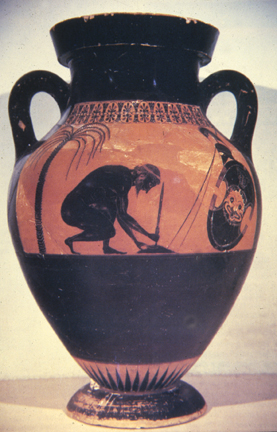In this companion piece to the last image, we see the 'Suicide of Ajax,' in another amphora painted by Exekias. Note the similarities between this and the last piece. Exekias skillfully balances light and dark areas, and leaves large amounts of negative space. The double honeysuckle pattern again adorns the frieze above the action. Here we see Ajax, but this time alone. Achilles has been killed in battle, and the loyal Ajax has retrieved his body from the Trojan enemy, but in an act of humiliation, he has been passed over for promotion to lead the army by his fellow Greeks. Instead, they chose Odysseus to lead them. Unable to bear the humiliation, Ajax commits suicide. While almost all other amphora painters depict the actual act of suicide in recounting this tale, Exekias characteristically shows instead the action leading up to the event. Here, Ajax has rested his shield (painted with the head of the Gorgon medusa), his helmet, and his spears, while he crouches under a tree. He is planting his sword in a mound of earth, and will soon fall upon it and die. This act of preparation is what interested Exekias, the inexorable nature of fate, rather than the actual moment of death. Note that in the Black Figure technique, bodies become silhouettes, and the only way the artist could convey detail was through Sgraffito, the technique of scratching through the slip to reveal the clay color below. This can be seen in the characteristic 'frontal' eye of Ajax.
The manner in which the creators of Black Figure ware were able to generate the strong black figures on the brick colored body of such pieces has been a matter of conjecture for some time. Recently it has been shown that the effect is not one of painting a black slip onto a brick colored ground as it might first appear. Rather the effect was achieved through an elaborate alternation of firing cycles. Here is how it is thought to have been achieved. First, the piece was thrown using a terra cotta (brick colored) clay body. After assembly and some drying, the form was burnished and the design painted in slip, but with slip that was the same color as the body. Outlines were painted first, and then filled in, with linear detail provided by sgraffito. It is only during the firing process that the color contrast would develop. The initial stage of the firing would involve a clear burning fire (oxidation) and this results in the clay taking on the vivid brick red color everywhere. Near the end of the firing, the damper of the kiln would be partially closed, creating an oxygen starved atmosphere in the kiln and creating smoke (referred to as reduction firing). The smoke impregnates the vessel, turning the entire piece black. Next, the damper is reopened briefly, allowing oxygen back into the kiln, clearing the atmosphere, and causing the blackened pot to gradually return to brick colored. Interestingly, the areas that had been painted with slip retain their black color longer than the unpainted areas. The Athenian potters had learned how to master this, and knew just how long to leave the damper open, so that only the unpainted areas returned to brick color, and the painted areas stayed black. So the entire visual effect is due to a clever and skillful manipulation of the firing cycle, making the creation of these vessels even more remarkable than previously thought.

The Suicide of Ajax, Black Figure Ware Amphora
Greek, 540 BCE


